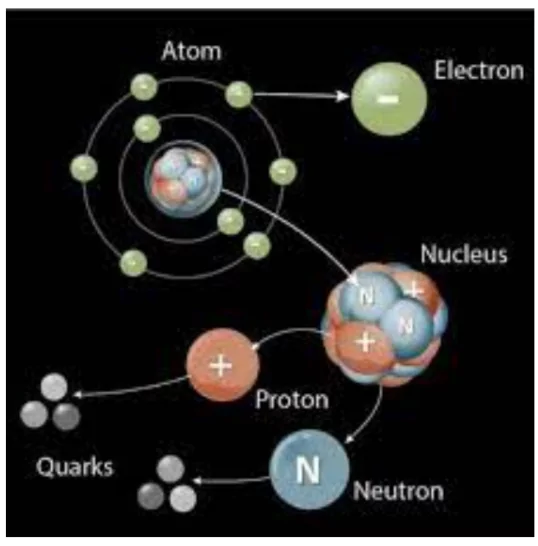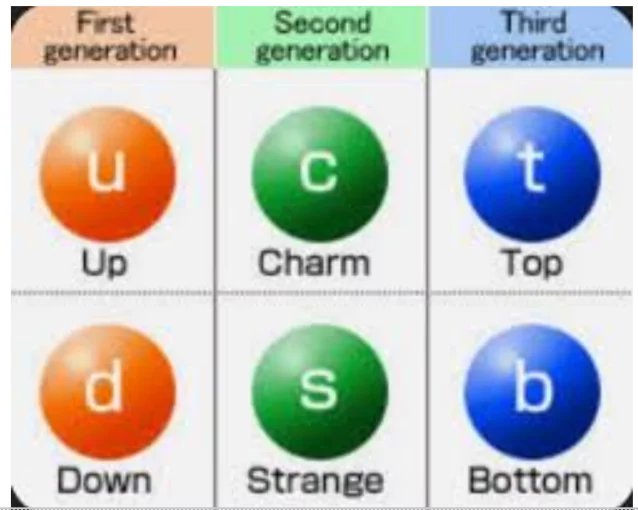Physicists at the Large Hadron Collider (LHC) in Europe reported the most precise mass measurement of the Top Quark at 172.52 GeV/c2 having implications for the whole universe.
About Quarks

- Elementary particles: Quarks are the ultimate building blocks of visible matter in the universe.
- They make up the protons and neutrons of an atom and lies on the ground floor of the Standard Model of particle physics.
- Experimental Evidence: At the Stanford Linear Accelerator Center (SLAC) in California in 1968, experimenters fired electrons, and muons, at protons, and found evidence that the electrons and muons were scattering off three smaller particles contained within the protons with each having their own electric charge.
- Bonds: Under normal condition Quarks are always bound together by the strong nuclear force and never exist alone forming composite particles called hadrons.
- Baryons: These are the particles made of three quarks which include protons (two up and one down quark) and neutrons (one up and two down quarks).
- Particles made of two quarks are called mesons.
 Flavours: In the present standard model, there are six “flavors” of quarks with each having its own set of quantum numbers, and with different masses.
Flavours: In the present standard model, there are six “flavors” of quarks with each having its own set of quantum numbers, and with different masses.-
- Up quark; Down quark; Strange quarks; Charm quark; Bottom quarks;Top quark ( It is the heaviest with a mass over 61,000 times more than the up quark)
About Top Quark
- Top Quark is the most massive particle scientists have found to date.
- It is 10-times heavier than a water molecule, about three-times as much as a copper atom, and 95% as much as a full caffeine molecule.
- Decay: The top quark is a very unstable particle and breaks up into lighter, more stable particles in less than 10−25 seconds.
- By the mass-energy equivalence, a more massive particle is also a more energetic particle and the more energetic particles often break down into ones with less energy.
- Discovery: Top Quark was discovered in 1995 at a particle accelerator in the US called the Tevatron, measuring its mass to be 151-197 GeV/c2 at first.
- Physicists at the Large Hadron Collider (LHC) in Europe reported the most precise figure yet at 172.52 GeV/c2.
Enroll now for UPSC Online Course
Significance of measuring the precise mass of Top Quark
- To understand Higgs Boson: Higgs Boson interacts most strongly with the top quark as it is the most massive subatomic particle. By measuring the top quark’s mass as precisely as possible, a lot can be known about the Higgs boson as well.
- Higgs Boson interacts with particles providing them with their mass. Without this aspect of nature no particles would have mass.
- Universe quantum tunnelling event: Measuring the top quark mass precisely has implications for whether our universe will tunnel out of existence as The Higgs boson with its mass of 126 GeV/c2 is the precise enough to keep the universe in its current state.
- The atoms of most chemical elements will be destroyed, taking stars, galaxies, and earthlife with them if the Higgs field was slightly stronger than it is now.
- Peculiar nature: To determine its oddball nature as on the one hand, it is the one closest to the Higgs boson’s mass and on the other hand, all the other particles like it are much, much lighter.
- Researchers will be able to incorporate the top quark’s mass measurement into calculations that inform our understanding of our universe’s particles.
- Finding more particles: Precisely measuring the top quark’s mass is also key to knowing whether some other particle with mass close to that of the top quark could be hiding in the data.
About Higgs Boson
- The Higgs boson is the fundamental force-carrying particle of the Higgs field, which is responsible for granting other particles their mass.
- Higgs field: It is an important source for all elementary particles which pervades the entire universe.
- A ‘field’ is like a sea of energy and excitations in the field are called particles. This way, for example, an excitation of the Higgs field is called the Higgs boson.
- Theorised: The Higgs field was first proposed in the mid-sixties by Peter Higgs
- Discovery: The particle was finally discovered on July 4, 2012, by researchers at the Large Hadron Collider (LHC)
- The LHC confirmed the existence of the Higgs field and the mechanism that gives rise to mass and thus completed the standard model of particle physics.
- Mass: The Higgs boson has a mass of 125 billion electron volts and is 130 times more massive than a proton .
- No spin: It is also chargeless with zero spin ( a quantum mechanical equivalent to angular momentum) It is the only elementary particle with no spin.
- A boson: It is a “force carrier” particle that comes into play when particles interact with each other, with a boson exchanged during this interaction.
- For example: When two electrons interact they exchange a photon (the force-carrying particle of electromagnetic fields), The Higgs boson is the particle/wave or “quantized manifestation” that arises from the Higgs field when excited.
- Brout-Englert-Higgs mechanism: The Higgs field generates mass via its interaction with other particles and the mechanism carried by the Higgs boson called the Brout-Englert-Higgs mechanism.
|
![]() 2 Jul 2024
2 Jul 2024

 Flavours: In the present standard model, there are six “flavors” of quarks with each having its own set of quantum numbers, and with different masses.
Flavours: In the present standard model, there are six “flavors” of quarks with each having its own set of quantum numbers, and with different masses.